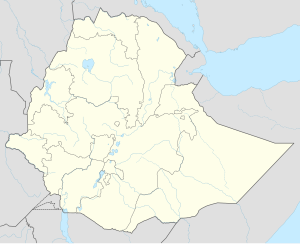Lalibela
|
Lalibela ላሊበላ |
|
|---|---|

The Church of Saint George, one of many churches hewn into the rocky hills of Lalibela
|
|
| Location in Ethiopia | |
| Coordinates: 12°01′54″N 39°02′28″E / 12.03167°N 39.04111°ECoordinates: 12°01′54″N 39°02′28″E / 12.03167°N 39.04111°E | |
| Country | Ethiopia |
| Region | Amhara Region |
| Zone | Semien Wollo Zone |
| Population (2007) | |
| • Total | 17,367 |
| Time zone | EAT (UTC+3) |
| Rock-Hewn Churches, Lalibela | |
|---|---|
| Name as inscribed on the World Heritage List | |

The Church of Saint George, showing its base and walls
|
|
| Location | Ethiopia |
| Type | Cultural |
| Criteria | i, ii, iii |
| Reference | 18 |
| UNESCO region | Africa |
| Inscription history | |
| Inscription | 1978 (2nd Session) |
Lalibela (Amharic: ላሊበላ?) is a town in Amhara Region, northern Ethiopia famous for monolithic rock-cut churches. Lalibela is one of Ethiopia's holiest cities, second only to Aksum, and a center of pilgrimage. Unlike Aksum, the population of Lalibela is almost completely Ethiopian Orthodox Christian. Ethiopia is one of the earliest nations to adopt Christianity in the first half of the fourth century, and its historical roots date to the time of the Apostles.
The layout and names of the major buildings in Lalibela are widely accepted, especially by local clergy, to be a symbolic representation of Jerusalem. This has led some experts to date the current church forms to the years following the capture of Jerusalem in 1187 by Muslim leader, Saladin.
Lalibela is located in the Semien Wollo Zone of the Amhara ethnic division (or kilil), at roughly 2,500 meters above sea level. It is the main town in Lasta woreda, which was formerly part of Bugna woreda.
During the reign of Saint Gebre Mesqel Lalibela (a member of the Zagwe Dynasty, who ruled Ethiopia in the late 12th century and early 13th century), the current town of Lalibela was known as Roha. The saintly king was named so, because a swarm of bees is said to have surrounded him at his birth, which his mother took as a sign of his future reign as Emperor of Ethiopia. The names of several places in the modern town and the general layout of the rock-cut churches themselves are said to mimic names and patterns observed by Lalibela during the time he spent as a youth in Jerusalem and the Holy Land.
...
Wikipedia

